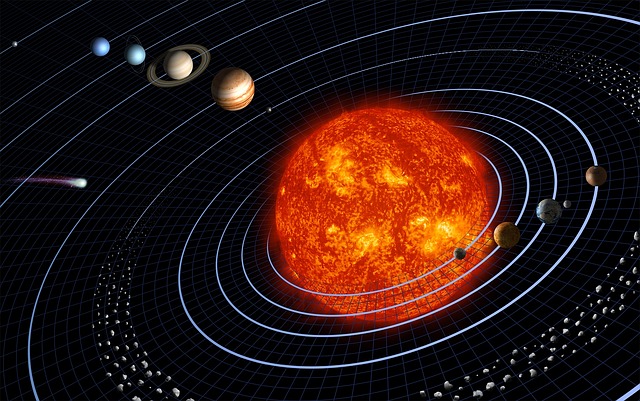Welcome to Earth & Space Day!
Session One
Ideas about the solar system works have developed over the centuries have changed. The geocentric model of the solar system gave way to the heliocentric model.
The Geocentric Model vs The Heliocentric Model
In astronomy, the geocentric model was a model of the universe where the Sun, Moon, stars, and planets all orbited Earth. The geocentric model was very popular in many ancient civilizations, such as Greece, Rome, and Egypt.
Ptolemy’s geocentric model was almost universally accepted until the appearance of simpler heliocentric models during the scientific revolution.
Ptolemy (Greco-Roman)
Ptolemy’s saw the universe as a set of nested spheres. He estimated the Sun was at an average distance of 1,210 Earth radii, while the radius of the sphere of the fixed stars was 20,000 times the radius of the Earth.
Alhazen (Iraq / Egypt)
Alhazen’s ideas on the universe were also geocentric but a little different from Ptolemy’s. Alhazen described a new, geometry-based planetary model, describing the motions of the planets in terms of spherical geometry and trigonometry.
Copernicus (Poland)
Nicolaus Copernicus was a mathematician and astronomer who formulated a model of the universe that placed the Sun rather than the Earth at the center of the universe.
Aristarchus (Greece)
Aristarchus of Samos was an ancient Greek astronomer and mathematician who presented the first known heliocentric model that placed the Sun at the center of the known universe with the Earth revolving around it.
Aristotle (Greece)
Aristotle pointed out correctly that if the size of the sun is greater than that of the earth and the distance of the stars from the earth many times greater than that of the sun.


Activity One
What are the differences?
What are the similarities?
What is meant by helio and geo?
Session Two
The sun is a star at the centre of our solar system and that it has 8 planets: Mercury, Venus, Earth, Mars, Jupiter, Saturn, Uranus and Neptune (Pluto was reclassified as a ‘dwarf planet’ in 2006).
What is the solar system? (use Chrome)
What about Pluto?
Mike Brown explains why he killed Pluto
Activity Two
Session Three
A moon is a celestial body that orbits a planet (Earth has 1 moon; Jupiter has 4 large moons and numerous smaller ones).
Our moon. You can also look at some other planetary moons here.
Activity Three
Session Four
Models of the sun and Earth enable us to explain day and night. You can compare the time of day at different places on the Earth through models.
Explore how the Earth is in day and night at different times of the day. here and here.
Activity Four
- Elite Dangerous.
- Explain Day and Night using this writing scaffold..
Session Five
Why do some people think that structures such as Stonehenge might have been used as astronomical clocks?
One of the most popular theories about Stonehenge is that it was an ancient observatory, used to mark midsummer. More recent evidence suggests that people did not just visit in the summer, but during the winter solstice when the sun sets between the largest of the central arches.
Others have suggested that the monument was used to predict solar and lunar eclipses.
Activity Five
Session Six
Construct a simple shadow clocks or sundials, calibrated to show midday and the start and end of the school day.
We are going to do this in the summer. Hold tight!
Earth and Space Day Deliverables.
- Geocentric and heliocentric model drawings with comments.
- Day and Night explanation.
- Drawing of Stonehenge.
